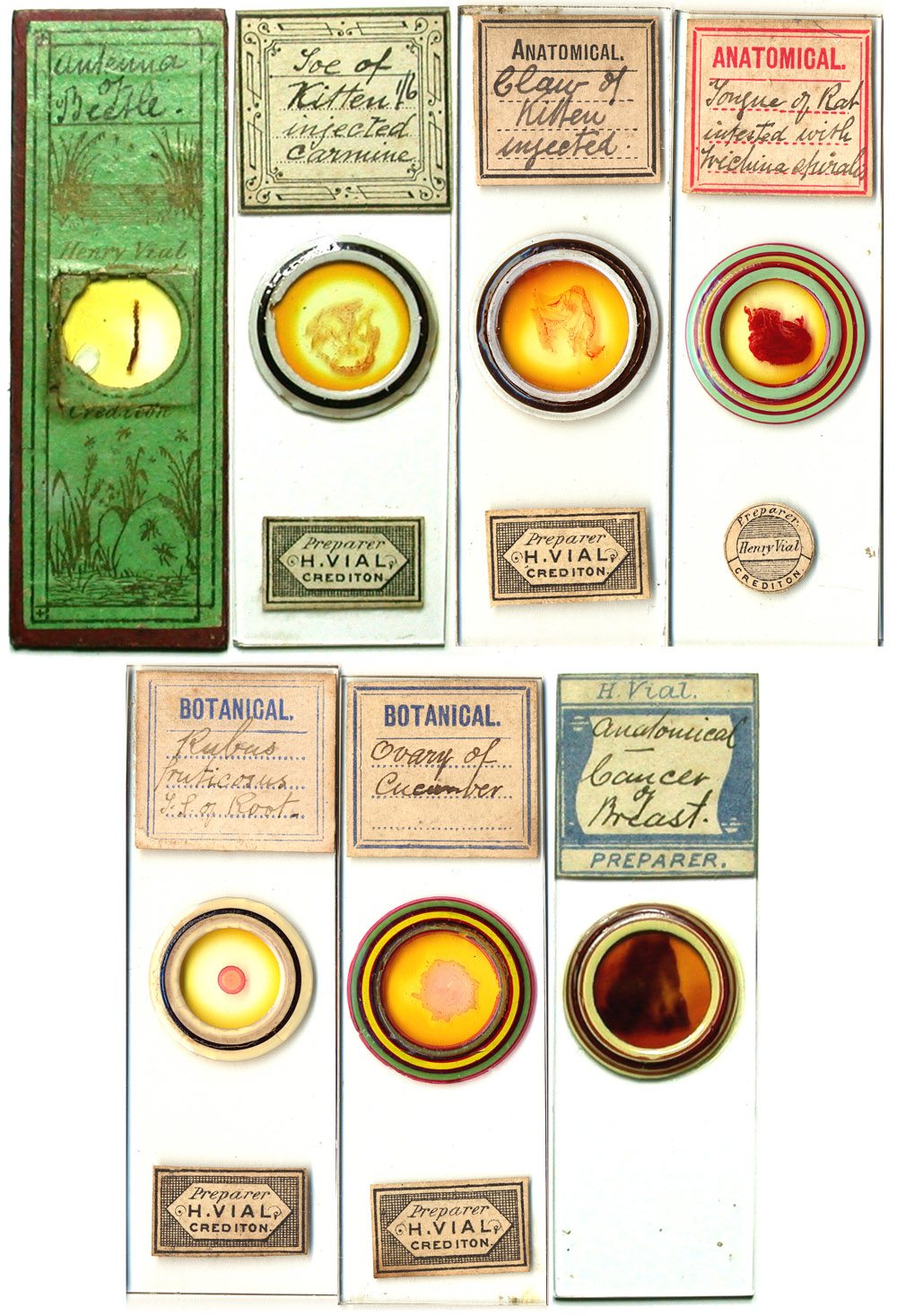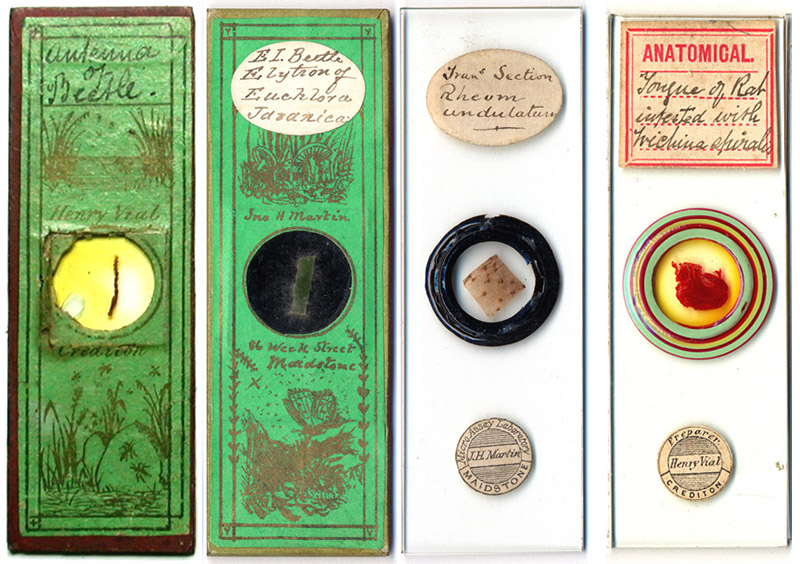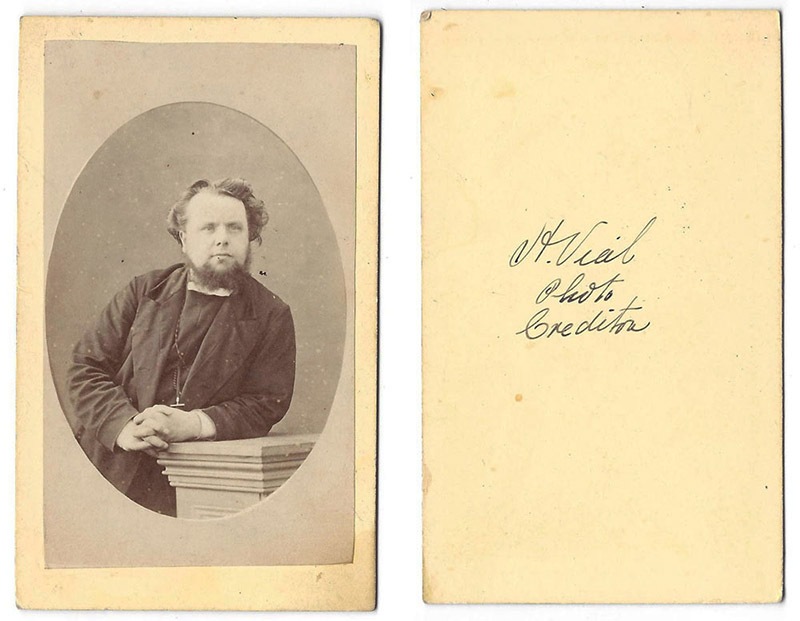Henry Vial, 1839 – 1894
by Brian Stevenson
last updated March, 2017
Henry Vial was a semi-professional microscope slide-maker, well known during his time for histological and botanical mounts. Vial actively advertised his slides for sale from the late 1870s through the end of the 1880s. Such sales probably supplemented the Vial family income, although Henry retained his day job as a clerk/accountant and business manager.

Figure 1.
Examples of microscope slides prepared by Henry Vial. Nearly all of Vial’s advertisements note his anatomical and botanical specimens, such as illustrated here. Vial often sealed coverslips with multiple concentric rings of contrasting colors. His use of bright colors, and the wide variety of combinations he used, would undoubtedly have caught the eye of his customers, as they do today’s collectors.

Figure 2.
Comparisons of some microscope slides by Henry Vial with those prepared by contemporary John H. Martin. The pattern on the Vial papered slide is strikingly similar to that used by Martin circa 1870. Martin drew the graphics for his slide-papers, and the similarities in style suggest that he also produced the artwork for Vial’s customized slide-papers. In addition, the small, circular labels used by Vial on his later slides are identical in style to those used by Martin’s Micro-Assay Laboratory during the mid-1870s. Although Vial and Martin lived on opposite ends of South England and were unlikely to have worked together, the labels imply that they were in close communication.
Henry Vial was born during the summer of 1839 in Camborne, Cornwall. His father, also named Henry, was a copper miner. The Vials clearly had higher plans for their eldest son. By 1861, Henry the son had left home for Crediton, Devon, where he worked as a clerk to a solicitor.
Henry married Ellen Browning in 1864, in Crediton. Their first son, born that year, was named Henry Browning Vial. Henry and Ellen had two more sons and two daughters over the next decade and a half.
Henry Vial was actively mounting microscope slides by 1878, and probably earlier. Vial advertised in Hardwicke’s Science-Gossip during 1878 to exchange “A bottle of Preliminary Varnish, and one ditto of white or coloured Enamel Cement, for good unmounted material. Micro, Fungi, Diatoms, Marine Algae, &c., preferred”. He also advertised “First-class micro-slides offered in exchange for live Water Beetles - Dyticus marginalis, Hydrous piccus, and Acilius sulcatus”. The first of those exchange offers indicates that Vial possessed mounting supplies. He was obviously working at mounting a wide variety of objects at the time. The request for live beetles would provide him with useable slide specimens, as opposed to dead insects which might be broken, dried-up or otherwise damaged. Presumably, the “first-class micro-slides” he offered where his own productions.
The following year, Vial offered to exchange “A variety of superior anatomical and pathological sections, stained and ready for mounting, in exchange for cleaned diatoms, polycistina, &c., Good slides of above for offers”. Thus, by 1879, Vial was preparing stained anatomical specimens for commercial purposes.
Also in 1879, Vial exhibited “a case of well-selected and carefully-prepared objects for the microscope, chiefly anatomical” at the Forty-seventh Annual Exhibition of the Royal Cornwall Polytechnic Society. For this display, he was awarded a First Bronze Medal in the Natural History division. The competition was not necessarily fierce, though. Other awards included “a first bronze medal to Mr. Oatey, who exhibited living ferns last year, and a book to a child of 8, for a carefully named collection from the neighbourhood”, and “A book on botany has been given to Miss Sharpe for a case of wild flowers. The specimens are too small to be characteristic, and are often not well chosen. They give evidence, however, of diligence and care in setting up, and are fairly classified, though some are incorrectly named”. Vial exhibited “a set of slides for the microscope, anatomical, pathological, and botanical” at the following year’s Exhibition, and again received positive attention.
During 1880, and through the rest of that decade, Vial’s exchange requests in Hardwicke’s Science-Gossip invariably offered anatomical specimens and slides, suggesting that he decided early on to specialize in large-scale production that type of subject. However, he requested to receive slides and unmounted specimens of all types. As examples, in 1880, he offered “Superior anatomical and pathological sections, stained and ready for mounting, in exchange for living parasites and other unmounted micro material”, “Superior anatomical and pathological sections, stained and ready for mounting, in exchange for mounted slides, insects preferred”, and “First-class anatomical and pathological sections, or mounted slides, in exchange for bone sections”. In 1881, he offered “First-class anatomical and pathological micro-slides in exchange for good stereoscopic slides”, and in 1884, “First-class anatomical and pathological microscope slides offered in exchange for good magic lantern slides” and “First-class anatomical and pathological sections from the human subject, and carmine injected sections from kitten and rabbit, in exchange for well-mounted slides. Desiderata, insect preparations, grouped diatoms, and botanical objects”. An 1882 exchange offer in the Northern Microscopist and Microscopical News took advantage of Vial’s 1879 prize, stating “Prize Medal. - Anatomical and Pathological Sections in exchange for stained vegetable sections, leaves, &c. Also, Diatoms or offers”.
Responses to Vial’s exchange offers must have been strong. He appears to have expanded his specimen and slide making business during 1885. In an obvious advertising ploy, he sent six slides to the editors of Hardwicke’s Science-Gossip, who described them as “admirable anatomical sections, beautifully mounted”.
Vial exhibited his wares at the 1886 Annual Meeting of the British Medical Association in Brighton, a considerable distance from home. He was noted as exhibiting “a number of Slides, Anatomical, Pathological, and Botanical, including stained specimens from human body, and injections from monkey, rabbit, cat, snake, etc.”.
Also in 1886, he sent additional slides to the editors of Hardwicke’s Science-Gossip, who commented “Mr. H Vial, Crediton, has also sent us three of his now well-known anatomical sections of the lower lip of monkey, kidney of monkey, and spleen of ditto, all injected with carmine” and “We have received from Mr. H. Vial, of Crediton, some of his newly-brought-out slides of pathological and botanical preparations. They are remarkable for their neatness, as well as for their scientific usefulness”.
By the following year, he was advertising his slides for sale, rather than simply in exchange, asking 5 shillings for a half-dozen slides.
The Journal of Microscopy and Natural Science, in 1889, reported that “We have received from Mr. H. Vial, of Crediton, Devon, Preparer of Anatomical, Pathological, and Botanical Objects for the Microscope, a beautifully mounted slide of Pleuro-Pneumonia from Lung of Cow. It is mounted on slip l by 3 inches, under 1 1/4 inch cover glass, which it fairly fills. The object is cut exceedingly thin and is nicely stained. We are informed that the price of this slide is 1s. 6d”.
A Science-Gossip exchange offer from 1886 indicates how Vial obtained many of his anatomical specimens: “Injected tissues from rabbit, cat, guinea pig, snake, frog, mouse, monkey, etc., either in bulk or sections, for insect or botanical slides”. That ad further suggests that Vial made slides of insect specimens for exchange and/or sale.
Vial also used his slides to barter for non-microscopical items, such as these 1887 offers from Science-Gossip: “Wanted, Devonian fossils in exchange for first-class micro slides” and “A good exchange in anatomical and pathological slides, including some first-class injections, for a good canary singing cage. Norwich or London fancy, or other canaries, Brahma or Leghorn fowl”.
Later in life, Vial took up professional photography (Figure 3). This may have been a part-time occupation, as the 1881 census listed his occupation as “accountant”, and the 1891 census, taken three years before Vial’s death, listed him as “Manager medicinal lozenge works”. Alternatively, Vial may have been a full-time photographer for the last 2-3 years of his life, noting that Henry’s 1894 death certificate described him as being a “master photographer”. Certainly, by the mid-1880s, Vial owned the equipment necessary for producing commercial photographs, as evidenced by this 1886 exchange offer: “What offers for a good plate mahogany camera and portrait lens, suitable for cards, &c., with stops complete, and also fitted with a dark slide for stereo-pictures with parallel bars, &c. ? – H. Vial, Crediton, Devon”.
The last microscopy-related item found for Henry Vial was a letter he wrote to the International Journal of Microscopy and Natural Science, regarding “ferret ticks” (Ixodes ricinus): “I shall be glad to know if these creatures have eyes or not. I cannot find any in the specimen sent. Henry Vial”.
Henry Vial died July 27, 1894, while visiting a cousin in Cornwall. The reported cause of death was “Chronic Gastritis, some years, Angina Pectoris and Syncope”, probably coronary thrombosis.

Figure 3.
A carte-de-visite (CDV) photograph, produced by Henry Vial, Crediton.
Acknowledgments
Thanks to Howard Lynk for sharing images, and to Peter Paisley for his insightful discussions of Henry Vial’s death record.
Resources
Annual Report (1879) Royal
Cornwall Polytechnic Society, Vol. 47, page 17
Annual Report (1879) Royal
Cornwall Polytechnic Society, Vol. 48, page 21
The British Medical Journal (1886) Fifty-fourth
Annual Meeting of the British Medical Association, page 453
Chemist and Druggist (1894)
Deaths - Vial, Vol. 45, page 232
Death record of Henry Vial (1894) Truro, Vol. 5c, page 77
England census, birth, marriage and death records, accessed
through ancestry.co.uk
Hardwicke’s Science-Gossip (1878)
Exchange requests, Vol. 14, pages 96 and 192
Hardwicke’s Science-Gossip (1879)
Exchange requests, Vol. 15, page 284
Hardwicke’s Science-Gossip (1880)
Exchange requests, Vol. 16, pages 167, 192 and 284
Hardwicke’s Science-Gossip (1881)
Exchange requests, Vol. 17, page 240
Hardwicke’s Science-Gossip (1884)
Exchange requests, Vol. 20, pages 96, 144, 216 and 264
Hardwicke’s Science-Gossip (1885)
Exchange requests, Vol. 21, pages 216, 266 and 283
Hardwicke’s Science-Gossip (1886)
Exchange requests, Vol. 22, pages 48, 163, 278 and 284
Hardwicke’s Science-Gossip (1887)
Exchange requests, Vol. 23, pages 168 and 264
International Journal of
Microscopy and Natural Science(1891) Letter, Vol. 10, page 91
The Journal of Microscopy
and Natural Science (1889) Note on Vial slide, page 72
Kelly’s Directory of Devon
and Cornwall (1893), Part 1, Devon & Localities, Crediton, page 134
The Naturalists’ Directory (1894)
Vial, Henry, page 24
The Northern Microscopist (1881)
Exchange requests, Vol. 1, page 24
The Northern Microscopist and Microscopical News (1882) Exchange requests, Vol. 2, page 356
The Scientific Enquirer (1887)
Advertisements from Henry Vial, Vol. 2, pages 60, 100 and 200


